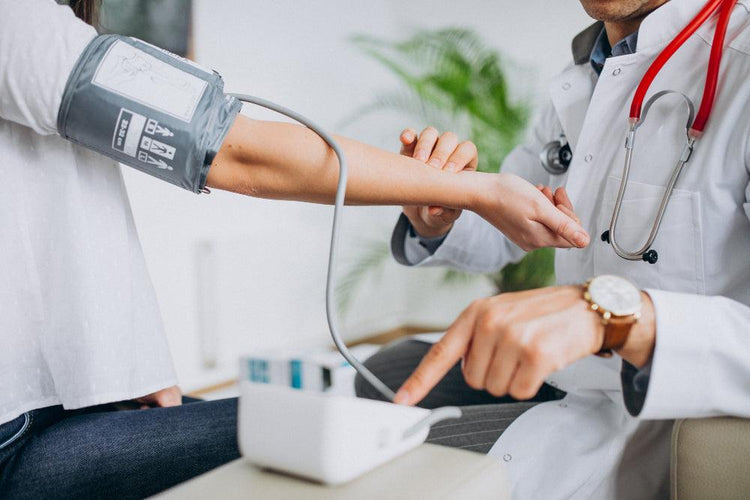What are normal oestradiol levels?
.png?v=1673356633397)

Related products
Oestradiol levels are typically tested using a simple blood test. In many cases, this is done as part of a broader hormone panel, especially when a patient is showing symptoms of hormonal imbalance or undergoing fertility assessment. For women, oestradiol tests are often timed according to specific phases of the menstrual cycle, as hormone levels naturally fluctuate throughout the month. A healthcare provider may request a test during the early follicular phase, mid-cycle ovulation, or the luteal phase depending on what they’re trying to investigate.
Common reasons to check oestradiol levels include irregular menstrual cycles, menopausal symptoms, fertility issues, suspected polycystic ovary syndrome (PCOS), or monitoring during hormone replacement therapy (HRT). For men, oestradiol may be assessed in the context of infertility, low libido, or signs of oestrogen dominance such as gynecomastia.
Testing is also valuable for individuals undergoing gender-affirming hormone therapy or those with conditions affecting adrenal or pituitary function. In these cases, a consistent and accurate measure of oestradiol helps monitor treatment effectiveness or disease progression.
If you're considering a hormone health check from home, Welzo’s Oestradiol Blood Test offers a convenient option. It provides accurate measurement of oestradiol levels and comes with expert-reviewed results to help you take informed steps based on your hormonal status.
In most cases, fasting is not required for an oestradiol test. However, it is always advisable to follow the specific instructions provided by the lab or your healthcare provider. Timing and consistency are crucial, especially when tracking hormone levels over time.
The results are usually reported in picograms per millilitre (pg/mL). These values should always be interpreted in context, considering age, sex, menstrual cycle phase, and any concurrent medications. Elevated or suppressed oestradiol levels do not diagnose a condition on their own but serve as a vital clue for further investigation.
Oestradiol and fertility: What’s the connection?
Oestradiol plays a key role in regulating the menstrual cycle and supporting reproductive health. Its levels rise during the first half of the cycle, peaking just before ovulation. This surge helps trigger the release of an egg from the ovary and stimulates the thickening of the uterine lining in preparation for implantation. Without adequate oestradiol, the chances of successful ovulation and conception are greatly reduced.
Low oestradiol can result in anovulatory cycles (where ovulation doesn’t occur), leading to infertility. High levels of oestradiol may interfere with the release of luteinising hormone (LH) and follicle-stimulating hormone (FSH), also impacting fertility. These hormonal imbalances are commonly seen in conditions like PCOS or as a result of stress, underweight conditions, or thyroid dysfunction.
For women actively trying to conceive or undergoing fertility treatments like IVF, monitoring oestradiol is essential. It helps doctors track the development of ovarian follicles and adjust medication dosages. Very high oestradiol levels during IVF may indicate overstimulation, which can be risky if not carefully managed.
A Female Fertility Test can be a helpful first step for those wanting insight into their reproductive hormones. It assesses key markers including oestradiol, LH, and FSH to give a clearer picture of ovulatory health.
Fertility is also influenced by overall health, including thyroid and adrenal balance. A Cortisol Blood Test can help detect stress-related hormone disruptions that may impact oestradiol levels and ovulation.
Oestradiol testing can be paired with ovulation predictor kits, progesterone tests, and ultrasound scans for a comprehensive fertility profile. Understanding the hormone’s role in fertility allows for better planning, more precise treatment, and increased chances of success.
How oestradiol affects bone, brain, and heart health
While oestradiol is most recognised for its reproductive functions, its influence reaches far beyond fertility. This hormone plays a significant role in maintaining bone density, cognitive function, and cardiovascular health, making it vital for long-term well-being.
In bones, oestradiol helps regulate the cycle of bone resorption and formation. It inhibits the activity of osteoclasts, the cells responsible for breaking down bone tissue. When oestradiol levels fall, particularly after menopause, this protective effect is lost. As a result, bone density decreases and the risk of osteoporosis and fractures increases. Women are especially vulnerable to this during and after menopause, highlighting the need for early detection and preventative strategies.
Oestradiol also influences brain chemistry and function. It affects the regulation of neurotransmitters such as serotonin and dopamine, both of which are linked to mood and emotional balance. This explains why many women experience mood swings, irritability, or even depression when their oestradiol levels fluctuate dramatically during the menstrual cycle or drop significantly during menopause.
In the cardiovascular system, oestradiol supports healthy blood vessels by improving elasticity, reducing inflammation, and regulating cholesterol. A drop in oestradiol is associated with increased levels of LDL (bad cholesterol) and decreased HDL (good cholesterol), which raises the risk of heart disease. This hormonal shift is partly why cardiovascular risk increases for women post-menopause.
For individuals concerned about heart and cholesterol health, a Cholesterol Blood Test can provide essential insights. When evaluated alongside hormone tests, it helps build a more complete picture of cardiovascular risk factors related to hormone imbalances.
Incorporating oestradiol testing into broader health assessments is important for individuals at risk of osteoporosis, cognitive decline, or heart disease. It enables early interventions and lifestyle changes that protect long-term health.
Oestradiol, thyroid function, and metabolic impact
Oestradiol is intricately linked with thyroid hormones and metabolic function. The endocrine system is highly interconnected, and imbalances in one hormone often lead to changes in others. Oestradiol, in particular, influences how the body metabolises food, regulates energy, and interacts with the thyroid.
In women, low oestradiol can contribute to symptoms like fatigue, weight gain, brain fog, and sluggish metabolism—symptoms commonly associated with underactive thyroid. In fact, oestrogen helps regulate the production and effectiveness of thyroid hormones. When oestradiol levels drop, the thyroid gland may slow down, resulting in hypothyroid-like symptoms.
Conversely, thyroid imbalances can also affect oestradiol production. Hypothyroidism, for example, can lead to irregular menstrual cycles or anovulation due to disrupted hormone signalling. It may also increase the risk of developing PCOS or worsen its symptoms. Hyperthyroidism can also impact reproductive hormone levels, though often in the opposite direction.
The interaction between oestradiol and insulin is also worth noting. Oestradiol helps improve insulin sensitivity, making it easier for the body to regulate blood sugar. Low levels may increase insulin resistance, leading to a higher risk of type 2 diabetes or metabolic syndrome.
If you're experiencing symptoms like unexplained weight gain, fatigue, or irregular periods, a Thyroid Function Blood Test is a valuable tool. It can help identify whether thyroid imbalance is playing a role in your symptoms, especially when evaluated alongside an oestradiol test.
For a broader snapshot of your health, the All Health Tests Collection offers a convenient way to screen for multiple conditions at once, from thyroid to vitamin and hormone profiles, all in one kit.
Conclusion
Understanding oestradiol and its impact on your body is a crucial step toward taking control of your health. While it is most commonly associated with reproduction, oestradiol affects far more than fertility. From mental clarity to metabolic balance, cardiovascular health to bone strength, this hormone influences nearly every system in the body. Keeping it within a healthy range is essential not only for women but also for men.
Testing your oestradiol levels can offer clarity around a variety of symptoms such as irregular periods, hot flushes, mood swings, low libido, and even more subtle changes like weight fluctuation or fatigue. When combined with other hormone tests—such as FSH, LH, progesterone, testosterone, and thyroid—you get a more complete understanding of your endocrine profile.
For anyone planning for pregnancy, experiencing menopausal symptoms, or managing hormonal health proactively, home testing makes it easy. The AMH Blood Test is particularly helpful for women assessing ovarian reserve and fertility planning, and it works well alongside an oestradiol test for a clearer picture.
Additionally, if your symptoms are linked to sexual health concerns, a broader view through the Sexual Health Tests Collection can help rule out other contributing factors such as STIs or hormonal imbalances.
To take the guesswork out of health tracking, consider using services like the Welzo Home Blood Tests page. It’s designed for anyone who wants clarity and confidence in their health, without needing to step into a clinic. With expert-reviewed results, medical-grade testing, and fast delivery, it’s one of the most convenient ways to stay informed and in control.

































 Rated Excellent by 26,523+ Reviews
Rated Excellent by 26,523+ Reviews